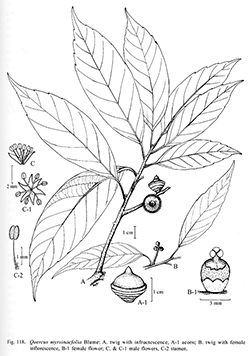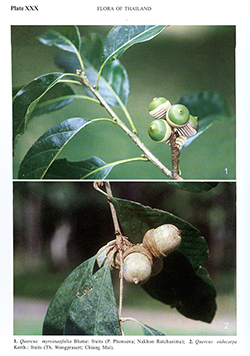e-Flora of Thailand
Volume 9 > Part 3 > Year 2008 > Page 385 > Fagaceae > Quercus
17. Quercus myrsinifolia Blumewfo-0000292104
Mus. Bot. 1: 305. 1851; Rehder & E.H.Wilson in C.S.Sargent, Pl. Wilson.: 236. 1917; Barnett, Quer. Rel. Fag. Asia: 233. 1940.— Cyclobalanopsis myrsinifolia (Blume) Oerst. Kongel. Danske Vidensk. Selsk. Skr., Naturvidensk. Math. Afd. V,9: 379. 1873; Schottky, Bot. Jahrb. Syst. 47: 656. 1912; Hjelmq., Dansk Bot. Ark., 23.4: 501. 1968. Fig. 116; C.C.Huang, Y.T.Chang & B.M.Bartol. in C.Y.Wu & P.H.Raven, Fl. China 4: 398. 1999. Fig. 118; Plate XXX: 1.
Accepted Name : This is currently accepted.
Synonyms & Citations :
Description : Tree, 9–30 m high, 40–180 cm girth. Axillary buds globose, ca 2 mm in diam., glabrous. Twigs lenticellate, blackish when dry. Bark dark grey, ca 2 cm thick, scaly; inner bark reddish; sapwood 25–30 cm thick, white. Leaves lanceolate or lanceolate-oblong, usually curved to one side, 6–18 by 2–5 cm; base cuneate, usually oblique; apex cuspidate or caudate; margins serrate in apical third; chartaceous, glabrous, dirty blackish on the upper surface when dry; midrib prominent on the lower surface; subdepressed on the upper; lateral nerves fine, curved, ending at the serrate points, scalariform veins hardly distinct. Petiole 1–3 cm, glabrous. Male inflorescence 2–3 simple or tufted, pendulous catkins, axillary and terminal, 5–10 cm long, pubescent, bracts and bractetoles ovate, acute, ca 2 by 1 mm, pubescent outside. Male flowers solitary or in 1–3–4-flowered cluster, perianth broadly campanulate, 6-lobed, 2 mm long, lobes narrowly triangular, divided halfway to the base, glabrous; stamens 6, ca 2 mm long, hairy near base. Female inflorescence spike erect, axillary to leaves and upper leaf scars, 1–2 cm long, pubescent then glabrescent, each spike in 3–5-flowered cluster, free, other characters as in male flowers; styles 3, connate; stigmata capitate. Acorns sessile, obovoid or ovoid, 1–1.5 by 1–1.5 cm (including cupule) on erect infructescence, 2–7 cm long, acorns free, 2–3 per infructescence. Cupule obconical, enclosing half of the nut, rim not dilated; wall comprising greyish hairs or scales, set in 7–9 rings or lamellae. Nut 1, mammilliform to conical, 2–2.5 by 2–2.7 cm, sparsely silky hairs then glabrescent.
Thailand : NORTHERN: Phitsanulok; NORTH-EASTERN: Phetchabun; EASTERN: Nakhon Ratchasima, Ubon Ratchathani; SOUTH-WESTERN: Kanchanaburi; CENTRAL: Nakhon Nayok; PENINSULAR: Ranong, Phangnga.
Distribution : Laos, Vietnam, China, Korea, Japan (type).
Ecology : Deciduous dipterocarp forests, dry evergreen forests, tropical evergreen rain forests, sandy soils or granite bedrock, often near streams, 50–900 m (most commonly 500–900 m). Flowering: February–December (most commonly October–December); fruiting: March–December (most commonly August–October).
Vernacular : Ko dang (ก่อด่าง), tao pun nok (เต้าปูนนก), sae (แส)(Peninsular).



